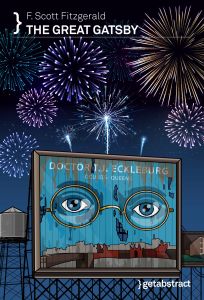
- Novel
- Modernism
What It’s About
An American Nightmare
“Let me tell you about the very rich,” F. Scott Fitzgerald wrote in his short story The Rich Boy. “They are different from you and me.” The author’s obsession with and intimate knowledge of class issues, wealth, and their effects on society, shines through every line of his masterpiece The Great Gatsby. First published in 1925, it’s an absorbing portrait of Jazz Age New York society in all its decadence and frenzied partying. The novel exposes the cynicism and inner emptiness of a class of people who seem to have it all but are empty. Jay Gatsby, who has gone from rags to riches via shady dealings, chases a materialistic dream which he mistakes for romantic love, only to lose everything when his fragile house of cards finally comes crashing down. Writing in 1927, two years before the onset of the Great Depression, Fitzgerald believed that a society built on the illusion of prosperity was ultimately doomed. “There has never been an American tragedy,” he told a bemused reporter, “there have only been great failures.” In the midst of the euphoric atmosphere of the pre-depression 1920s, his message didn’t go down well. Today, The Great Gatsby is considered one of the finest accomplishments in American literature – a painfully beautiful and gripping testimony of wasted opportunities. Recent history underlines its continuing relevance and the urgency of its central themes.
Summary
About the Author
Francis Scott Fitzgerald was born on September 24, 1896, the son of an upper-middle-class businessman in Saint Paul, Minnesota. After attending a Catholic prep school in New Jersey, he studied at Princeton University, but dropped out before attaining a degree and enlisted in the military in 1917. While based in Montgomery, Alabama, he met his future wife Zelda Sayre. She agreed to marry him, yet postponed the wedding repeatedly on the grounds that Fitzgerald wasn’t wealthy enough. Zelda feared the boredom of a financially restricted life. Only in 1920, when his first novel This Side of Paradise became a success and made him famous overnight did she give her consent.His next work The Beautiful and Damned, published in 1922, became a bestseller as well. After the success of these two novels and Tales of the Jazz Age, (1922) the couple’s wild and glamorous lifestyle came to embody the Roaring Twenties. From 1924 to 1931 they lived with their daughter Scotty on the French Riviera and in Paris, where Fitzgerald completed The Great Gatsby. Against all expectations, the novel flopped, and the couple got into more and more financial trouble. Excessive drinking impinged on Fitzgerald’s writing, and the money for their lavish lifestyle ran out. Zelda suffered several nervous breakdowns after the failure of her novel. After she entered a mental institution in Baltimore, Maryland, the marriage broke apart. Fitzgerald’s next novel Tender Is the Night (1934) was equally praised by the critics and ignored by the public. He tried, rather unsuccessfully, to work as a scriptwriter in Hollywood and abandoned himself fully to alcohol. His last novel The Last Tycoon remains unfinished. Fitzgerald died of a heart attack, deeply in debt and embittered, at age 44 on December 21, 1940. USA Today wrote in 2013 that he “died believing his work forgotten.”









Comment on this summary